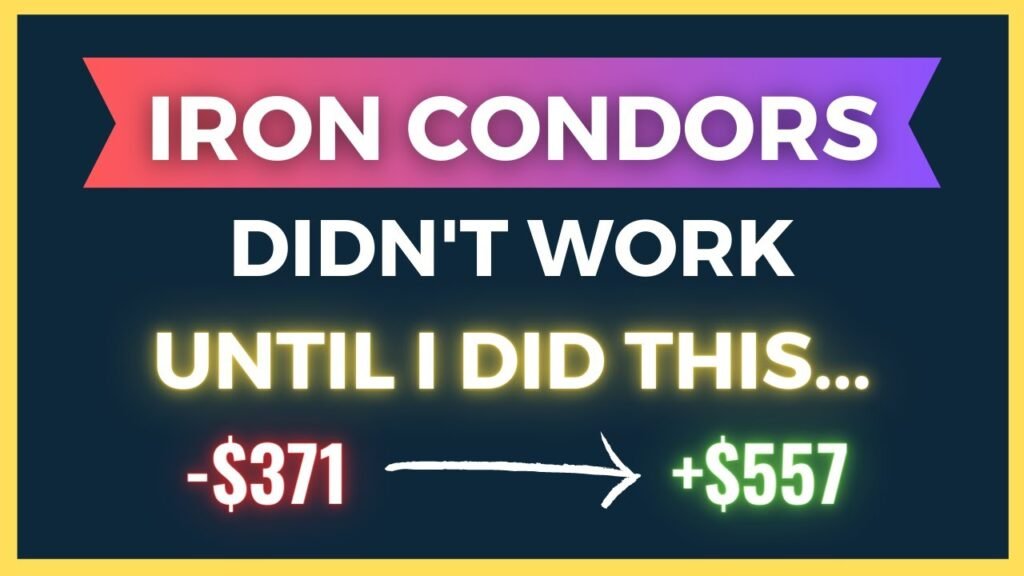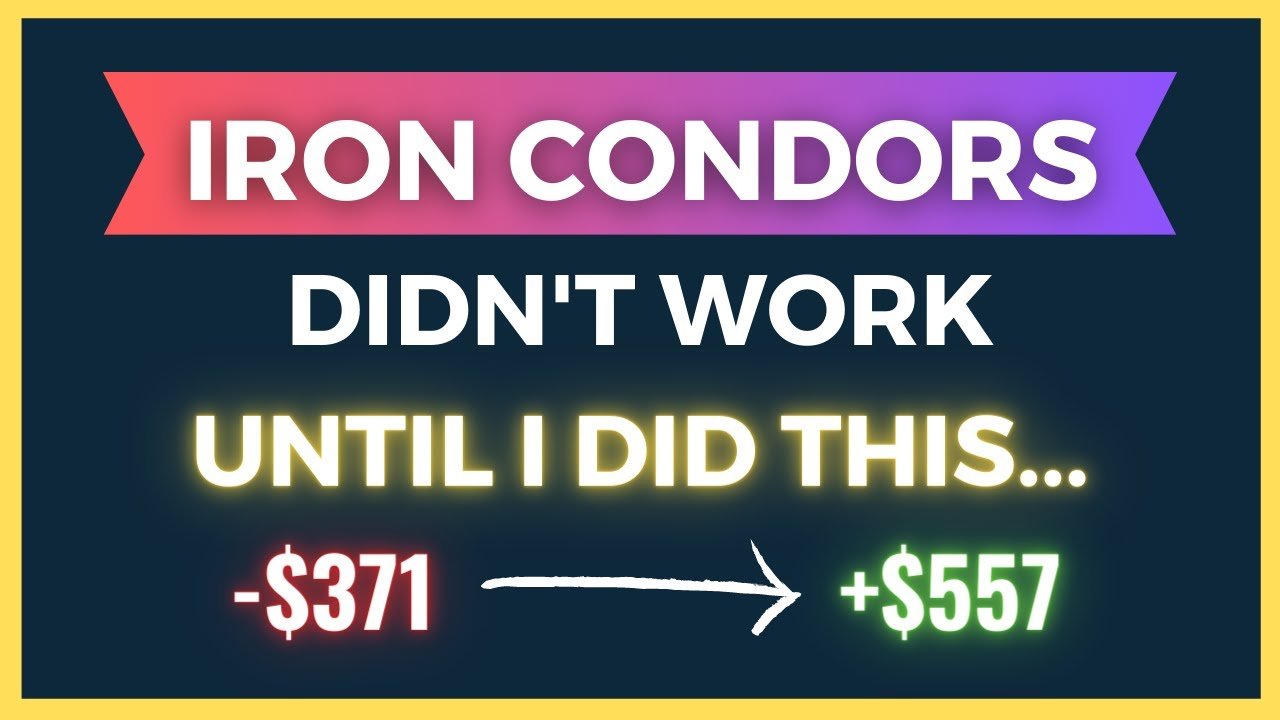In “The Complete Beginner’s Guide To Managing Losing Iron Condors” video by Options with Davis, you’ll learn essential strategies for effectively managing your losing Iron Condor trades. The video emphasizes the importance of correctly managing Iron Condor trades to prevent potential losses from escalating. It provides timestamps for specific sections, including the Iron Condor PnL Graph and managing your Iron Condor Trade. Additionally, the video mentions other related videos that viewers might find interesting and offers a free Options Income Blueprint. Whether you’re new to options trading or looking to enhance your knowledge, this video serves as a valuable resource to optimize profitability and minimize risk when managing Iron Condors.

Section 1: Understanding Iron Condors
1.1 What are Iron Condors?
Iron Condors are a popular options trading strategy used to generate income by selling both a put spread and a call spread on the same underlying asset. It gets its name from the shape of the profit/loss graph, which resembles the wings of a condor.
The strategy involves selling out-of-the-money (OTM) put options and OTM call options, while simultaneously buying further OTM put options and call options as protection. By doing so, traders create a range within which they expect the price of the underlying asset to remain until expiration. If the price stays within this range, the options expire worthless and the trader keeps the premium received from selling the options.
1.2 Differences between Iron Condors and Credit Spreads
While both Iron Condors and Credit Spreads involve selling options to generate income, there are a few key differences between the two strategies.
Firstly, Iron Condors involve selling both a put spread and a call spread, while Credit Spreads only involve selling either a put spread or a call spread. This means that Iron Condors have a wider range of profitability, as they can profit whether the price of the underlying asset goes up, down, or stays within a certain range.
Secondly, Iron Condors tend to have a higher probability of profit compared to Credit Spreads, but at the cost of a lower maximum profit potential. This is because Iron Condors involve selling options that are further away from the current price of the underlying asset, resulting in a higher probability of those options expiring worthless.
1.3 Skewed Iron Condors and Put Skews
In some cases, index ETFs like SPDR S&P 500 ETF (SPY), Invesco QQQ Trust (QQQ), and iShares Russell 2000 ETF (IWM) exhibit put skew, which means that put options are relatively more expensive compared to call options. This can create an opportunity to trade skewed Iron Condors.
Skewed Iron Condors have different size widths on each side due to the put skew. Traders can take advantage of this skew by widening the put side of the Iron Condor, allowing for potentially higher premiums on the put spread. It’s important to note that skewed Iron Condors require a higher level of experience and understanding, and are not recommended for beginners.
1.4 Risk Profile of an Iron Condor
Understanding the risk profile of an Iron Condor is crucial for effectively managing the trade. The risk profile is represented by the profit/loss (PnL) graph, which shows the potential profit and loss at expiration and during the current day.
The PnL graph of an Iron Condor resembles the wings of a condor, with defined profit zones and potential loss areas. The goal is for the price of the underlying asset to stay within the range of the profit zones, allowing the options to expire worthless and the trader to keep the premium received from selling the options.
It’s important to note that an Iron Condor has limited profit potential and a defined maximum loss. Traders should carefully consider the risk-reward ratio before entering into an Iron Condor trade, as managing risk is a key aspect of this strategy.
Section 2: Importance of Managing Iron Condors Correctly
2.1 Managing Iron Condors at 21 Days to Expiration
Managing Iron Condors correctly is crucial to prevent greater losses and optimize results. One key point to consider is managing the trade at around 21 days to expiration.
At 21 days to expiration, time decay, also known as theta decay, starts accelerating. Theta decay refers to the decrease in the value of options as time passes. By managing the trade at this point, traders can take advantage of the accelerated time decay to potentially close the position for a profit or mitigate potential losses.
2.2 Optimizing Results Through Management
Properly managing Iron Condors can greatly impact the overall performance of the trade. Traders should regularly monitor the position and make adjustments as necessary based on market conditions and the price movement of the underlying asset.
By adjusting the position, such as rolling out the options or widening the strikes, traders can potentially improve the risk-reward ratio and increase the probability of success. This active management approach allows traders to adapt to changing market conditions and optimize the results of their Iron Condor trades.
2.3 Minimizing Risk and Potential Losses
One of the main goals in managing Iron Condors is to minimize risk and potential losses. By closely monitoring the trade and implementing appropriate risk management strategies, traders can mitigate losses and protect their capital.
There are several techniques for minimizing risk in Iron Condors, such as adjusting the position when the price of the underlying asset breaches predefined levels or when volatility increases significantly. These adjustments may involve closing out losing options positions, rolling out the Iron Condor for a credit, or managing the trade as a single put spread or call spread.
By carefully implementing risk management strategies, traders can limit potential losses and protect their overall portfolio.
Section 3: Strategies for Managing Losing Iron Condors
3.1 Closing Options Positions at a Loss
One strategy for managing losing Iron Condors is to close out the options positions at a loss. This involves buying back the options that were sold and selling the options that were bought as protection.
Closing out the positions at a loss allows traders to limit potential further losses and free up capital to deploy in other trades. While closing out at a loss means accepting a loss on the trade, it can be a prudent decision to prevent greater losses.
3.2 Rolling Out the Iron Condor for a Credit
Another strategy for managing losing Iron Condors is to roll out the position for a credit. This involves closing out the current position and simultaneously opening a new Iron Condor with a wider width or adjusted strikes.
Rolling out the Iron Condor for a credit allows traders to potentially reduce the maximum loss and extend the duration of the trade. By collecting a credit through the roll, traders can offset some of the previous losses and improve the risk-reward ratio of the trade.
3.3 Managing as a Single Put Spread or Call Spread
In some cases, when a losing Iron Condor cannot be effectively managed through closing out or rolling, it may be necessary to manage the trade as a single put spread or call spread.
By converting the Iron Condor into a single put spread or call spread, traders can potentially limit losses and salvage some of the initial premium received. This strategy involves closing out one side of the Iron Condor while keeping the other side intact.
Managing as a single put spread or call spread requires careful consideration of the risk-reward profile and potential market movements. Traders should assess the potential profitability and risk of the new position before implementing this strategy.
3.4 Rolling the Entire Iron Condor and Untested Side
In certain scenarios, when managing a losing Iron Condor, it may be possible to roll the entire Iron Condor and the untested side, instead of closing the position outright.
Rolling the entire Iron Condor and the untested side involves closing out the existing position and simultaneously opening a new Iron Condor with adjusted strikes and/or width. This strategy allows traders to potentially extend the duration of the trade and potentially reduce the maximum loss.
Rolling the entire Iron Condor and the untested side requires careful analysis of the market conditions and consideration of potential profit and losses. Traders should assess the risk-reward ratio and make adjustments accordingly.
Section 4: Steps to Manage Losing Iron Condors
4.1 Assessing the Current Iron Condor Trade
The first step in managing a losing Iron Condor is to assess the current trade. Traders should review the risk profile, profit/loss potential, and the current market conditions. This assessment will help determine the appropriate management strategy.
By understanding the current state of the trade, traders can make informed decisions and take appropriate actions to mitigate losses and protect their capital.
4.2 Determining the Best Management Strategy
After assessing the current Iron Condor trade, the next step is to determine the best management strategy. This decision will depend on factors such as the current price of the underlying asset, the time to expiration, and the trader’s risk tolerance.
The chosen management strategy may involve closing out the position at a loss, rolling out the Iron Condor for a credit, managing as a single put spread or call spread, or rolling the entire Iron Condor and untested side. Each strategy has its own advantages and risks, and traders should carefully consider the potential outcomes before making a decision.
4.3 Implementing the Chosen Management Strategy
Once the best management strategy has been determined, it’s time to implement it. This may involve closing out options positions, opening new positions, or making adjustments to the existing position.
Timing is crucial when implementing the chosen management strategy. Traders should closely monitor the market and execute the necessary trades at the appropriate time to optimize the results.
Implementing the chosen management strategy requires discipline and adherence to the predetermined plan. By following through with the strategy, traders can effectively manage losing Iron Condors and potentially turn them into profitable trades.
Section 5: Other Resources and Related Videos
5.1 Options Income Blueprint
Options with Davis offers a free Options Income Blueprint, which provides additional information and strategies for generating income through options trading. The Options Income Blueprint can be a valuable resource for traders looking to expand their knowledge and improve their trading skills.
5.2 Additional Videos for Further Learning
Options with Davis also offers other related videos that viewers may find helpful for further learning. These videos cover various topics related to options trading, including high-probability consistent income strategies, recurring profits with the wheel strategy, and mastering covered calls.
By exploring these additional resources and related videos, traders can continue to enhance their understanding of options trading and improve their overall trading performance.
Conclusion
Managing losing Iron Condors is an important aspect of options trading. By understanding the fundamentals of Iron Condors, implementing appropriate risk management strategies, and making well-informed decisions, traders can mitigate potential losses and optimize the profitability of their trades. It’s crucial to regularly monitor the position, assess market conditions, and adjust the trade as necessary to ensure the best possible outcome. By following the steps outlined in this article and utilizing additional educational resources, traders can improve their skills and become more successful in managing losing Iron Condors.
